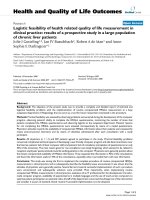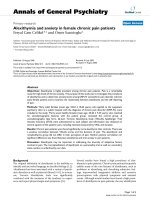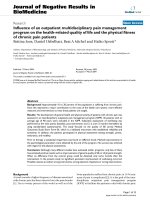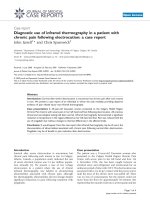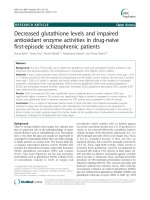Characterization of new peptides and physiological amino acids present in cerebrospinal fluid of chronic pain patients
Bạn đang xem bản rút gọn của tài liệu. Xem và tải ngay bản đầy đủ của tài liệu tại đây (645.94 KB, 218 trang )
CHARACTERIZATION OF NEW PEPTIDES AND
PHYSIOLOGICAL AMINO ACIDS PRESENT IN CEREBROSPINAL
FLUID OF CHRONIC PAIN PATIENTS
SETHURAMAN RAMA
M.Sc. (Biochemistry), M.Tech. (Biotechnology)
A THESIS SUBMITTED FOR THE DEGREE OF
DOCTOR OF PHILOSOPHY
AT THE
DEPARTMENT OF ANAESTHESIA
SCHOOL OF MEDICINE
NATIONAL UNIVERSITY OF SINGAPORE.
2005
ii
To
My husband,
K.Ramachandran
For all his patience, support and encouragement.
iii
Preface
I hereby would like to express my deepest gratitude and thanks to my supervisor Dr.
Shinro Tachibana, for his support and advice during the entire course of this work.
My research career at the National University of Singapore has been fruitful and my
research interests have blossomed well under his able guidance and motivation.
Without his constant encouragement and directions, this work would not have been
possible.
My sincere thanks are also due to Prof. Lee Tat Leang, who has supported our work
constantly and helped us to procure the valuable samples for our research. I also
express my thanks to Prof. Peter Wong, Department of Pharmacology for letting us
use his lab facility for binding assays and the staff of the Research labs of Department
of Obstetrics and Gynaecology, National University Hospital for allowing the use of
their radioactive work place.
I also express my appreciation to Ms. Ting Wee Lee, Department of Pharmacology
for her technical support in this work. My special thanks to Chun Mei for all her
technical help during my difficult days. My thanks are due also to my colleagues and
members of our research group – Dr. Tessy, Jayasree, Karen, Dr. Eugene and Dr.
Jamil for their help and useful discussions. I would like to record my thanks to my
friends in NUS – Kiruba, Abirami, Prathiba and many others who have brightened
my days as a student here.
This entire work has been possible because of the support of the scholarship from
National University of Singapore.
iv
I express my heartfelt thanks to my husband whose fortitude and support has made
this dream come true for me. I also record my deepest gratitude to my dear parents
who have been a great inspiration for me and have always nurtured my academic
interests since young. I am also thankful to the other members of my family – my kith
and kin who have always supported me in many different ways.
Above all I thank the almighty God, for blessing me in numerous ways and guiding
me through all the rougher patches in life.
v
Table of Contents
Page
ii Dedication
iii Preface
v Table of Contents
vii Summary
ix Research Collaborations
x Publications
xii List of Figures
xiv List of Tables
xvi List of Abbreviations
1 Chapter One Introduction
An Overview of Pain, its physiology, classification and molecular
mechanisms of pain, role of amino acids and known peptides in pain
perception mechanisms
36 Chapter Two A Simple Quantitative HPLC method for measuring
Physiologic amino acids in Cerebrospinal fluid.
Development of a new method for quantitative analysis of physiological
amino acids in cerebrospinal fluid without pretreatments and evaluation of this
analysis method.
60 Chapter Three An analysis of amino acid neurotransmitters and nitric
oxide in acute labor pain.
Applying our new method for amino acid analysis in CSF to analysis of
physiological amino acids and other pain related molecules in the
cerebrospinal fluid of pregnant women with and without labor pain.
.
vi
82 Chapter Four A comparative study on the roles of amino acid
neurotransmitters and nitric oxide in chronic and acute
pain.
Analysis of pain-related amino acids including the nitric oxide markers –
citrulline and arginine in CSF of chronic pain patients by applying our HPLC
method and a comparison to their levels in acute pain and no pain controls.
103 Chapter Five Purification of peptides from cerebrospinal fluid of
chronic pain patients.
Three peptides were purified by adopting a new strategy different from
proteomics from cerebrospinal fluid and sequences were confirmed.
123 Chapter Six Bioactivity studies on the 7B2CT peptide.
The 7B2CT peptide was studied for its pain related bioactivities by
intrathecal administration into mice using the allodynia assay.
134 Chapter Seven Characterization of 7B2CT peptide isolated from
cerebrospinal fluid – Receptor binding studies.
Specific binding sites for the 7B2CT peptide in mice and rat brain tissues
were identified. Distribution of these binding sites in the brain and also
correlation of these binding sites to pain were studied.
157 Chapter Eight Structure-activity relationship of the 7B2CT peptide
The sequences in the structure of the 7B2CT peptide responsible for its
pain-related bioactivity and the sequences essential for binding to the
receptors were analyzed.
170 Chapter Nine Overall Discussion and Conclusions
176 Bibliography
vii
Thesis Summary
This research work focuses on trying to elucidate the underlying mechanisms of
chronic pain. Here CSF samples obtained from chronic pain patients were analyzed in
two perspectives: Firstly a new simple analysis method using HPLC for amino acids
in CSF was developed, which was then subsequently applied to quantitatively analyze
all physiological amino acids especially the nine pain-related amino acids (asparagine,
aspartate, GABA, glutamate, glutamine, glycine, taurine, arginine and citrulline – NO
markers) in the CSF of pregnant women in labor pain – as a representative acute pain
and in no pain Caesarian patients. This method was also applied to analyze CSF
samples from chronic pain patients and the data were all compared against acute pain
and no pain control subjects. Though the excitatory and inhibitory amino acids are
known to be important neurotransmitters, their direct correlation to different types of
pain has not been so far studied. The amino acid analysis data from this work throws
light on the differential roles of these pain-related amino acids in the different pain
states and hints on possible roles for some of these amino acids as potential
biomarkers for various pain conditions.
Secondly, a pain-related peptide – 7B2-C-terminal peptide (7B2CT) was isolated
from the CSF of chronic pain patients by applying a multiple liquid chromatographic
strategy – very different from proteomics technology. Though earlier known, the
extracellular pathophysiological roles for this peptide especially related to pain
mechanisms have not been studied to date. Attempts were made to characterize this
7B2CT peptide using animal models and in vitro binding studies. The bioactivity
viii
studies on this peptide showed mechanical allodynia – pain hypersensitivity evoked
by innocuous stimuli characteristic to neuropathic pain, by intrathecal administration
of this peptide in naïve mice. This allodynic response was enhanced in neuropathic
pain mouse models. The specific binding sites for this peptide have been shown to
exist by receptor binding studies using membrane fractions from mouse brain and
spinal cord and the regional distribution of these binding sites in rat and mouse brain
were also analyzed. Further, these binding sites were increased in membrane fractions
prepared from neuropathy model mice. In addition, some structure-function analyses
on this peptide for its pain-related activity were also performed to identify the
sequences in this peptide responsible for its bioactivity and receptor binding
properties. The N-terminal hexadecapeptide fragment of this peptide produced the
same allodynia effect as 7B2CT while the C-terminal tridecapeptide fragment showed
the binding activity of 7B2CT and also interestingly blocked the allodynia evoked by
7B2CT. The results from these peptide studies have identified possible important
roles for this 7B2CT peptide in chronic pain perception and have opened new
channels of research for the development of more effective therapeutics in chronic
pain management.
In a nutshell, the main scope of this study has been to analyze and explicate chronic
pain mechanisms from two viewpoints – amino acids analysis and peptide isolation
from CSF and thus attempt to contribute to the management of unyielding chronic
pain.
ix
Research Collaborations
Some bioactivity data discussed in this thesis was collected in the following
collaborating laboratory:
Prof. T. Minami,
Department of Anaesthesiology,
Osaka Medical College,
Osaka, Japan.
The purification of labeled tracer for saturation receptor binding assay was kindly
done by the following collaborating laboratory:
Prof. S. Hirose,
Department of Biological Sciences,
Tokyo Institute of Technology,
Yokohama, Japan.
All the synthetic peptides used in this work were promptly synthesized in the
following Institute:
Dr. Y. Nishiuchi
Peptide Institute Inc.,
Osaka, Japan.
All their contributions are gratefully acknowledged.
x
Publications
Sethuraman R, Lee TL, Tachibana S. Simple quantitative HPLC method for
measuring physiologic amino acids in cerebrospinal fluid without pretreatment. Clin
Chem 2004;50:665-9.
Sethuraman R, Lee TL, Chiu JW, Tachibana S. An analysis of excitatory and
inhibitory amino acids and nitric oxide in pregnant women with and without labor
pain. J Pain 2006; Manuscript submitted.
Sethuraman
R, Lee TL, Joseph
T, Kazi JA, Liu EHC, Li
CM, Tachibana S et al. New
roles of 7B2 C-terminal peptide in neuropathic pain as neuromodulator. Manuscript
in preparation.
Conference Abstracts - Posters:
Sethuraman R, Lee TL, Tachibana S. Analysis of amino acids from cerebral spinal
fluid from patients with chronic pain. (2004). 13th World Congress of
Anaesthesiologists. 18-23 Apr 2004, Paris, France.
Sethuraman R
, LeeTL, Chiu JW, Tachibana S. Simple HPLC method for amino
acids analysis in CSF (2004). 2nd Singapore International Neuroscience Conference,
22 -23 July 2004, National Neuroscience Institute, Singapore.
Lee TL, Sethuraman R, Chiu JW, Tachibana S. Differential amino acid profile in the
cerebrospinal fluid of parturients with and without labour pain. (2004). Annual
xi
Meeting of the American Society of Anesthesiologists. 23-27 Oct 2004, Las Vegas,
USA.
Sethuraman R, LeeTL, Chui JW, Tachibana S. Perspectives of Pain Therapy - Do
Amino acids in CSF define pain? (2004). 8th NUS-NUH Annual Scientific Meeting.
7-8 October, 2004, National University of Singapore, Singapore.
xii
List of Figures
Chapter 2 Page
2.1 HPLC separation of dabsyl derivates 55
Chapter 3
3.1 Typical chromatograms of CSF samples from the two
pregnant groups. 76
3.2 Comparison between Pain related amino acids in CSF of Citrulline
positive labor pain patients Vs Citrulline negative labor pain patients. 78
3.3 Correlation between Pain intensity (PI) and the concentration of
Pain related amino acids in cerebrospinal fluid of the labor pain group. 80
Chapter 4
4.1 Chromatograms of CSF samples from the three patient groups. 100
4.2 Comparison between Pain related amino acids in CSF of Chronic pain
and Acute pain patients. 102
Chapter 5
5.1 Chromatograms of the Analytical HPLC purification and microbore
HPLC final purification steps. 118
5.2 Staining results of Peaks 1, 2 and 3 purified from CSF. 119
5.3 Sequences of the trypsin digestion fragments obtained from Peak 1 &
Peak 3 during MS MS sequencing. 119
5.4 Co-elution experiment chromatograms for 7B2CT peptide. 120
5.5 Structure confirmation experiment chromatograms for chromogranin A
fragment peptide. 121
5.6 Evidence for the tendency of Oxidation of Synthetic Chromogranin A
fragment. 122
xiii
Chapter 6
6.1 7B2CT evoked allodynic response sustained even after 50 minutes. 131
6.2 Bell-shaped dose response curve for 7B2CT in allodynia assay. 132
6.3 Mechanical allodynia assays in neuropathy pain models. 133
Chapter 7
7.1 Saturation curve for binding of HPLC purified
125
I-labelled 7B2CT
to mouse brain synaptosome membranes. 151
7.2 Comparison of saturation binding of
125
I-labelled 7B2CT to the
synaptosome membranes prepared from mouse brain and spinal cord. 152
7.3 Specific binding sites in neuropathy and inflammation pain model
mice brain as compared to the normal control mice. 155
Chapter 8
8.1 Strong allodynic response of 7B2CT-N sustained after 50 minutes. 166
8.2 Dose response in allodynia assay for 7B2CT-N & 7B2CT-C fragments. 167
8.3 Replacement curves for the displacement of
125
I-labeled 7B2CT
binding to mouse brain synaptosomes by 7B2CT peptide, 7B2CT-C
and 7B2CT-N fragments. 168
8.4 Allodynia responses for 7B2CT peptide antagonized by co-injection
with different doses of 7B2CT-C. 169
xiv
List of Tables
Chapter 1 Page
1.1 Physiology of the nociceptive system. 6
1.2 Glutamate receptor pharmacology in the Central nervous system. 15
1.3 GABA receptors pharmacology in the central nervous system. 17
1.4 Amino acid sequences of some mammalian opioids. 24
1.5 Opioid Receptor types – their endogenous ligands, selective agonists
and antagonists. 27
1.6 Amino acid sequences of some mammalian Tachykinins. 28
1.7 Amino acid sequence of Bradykinin and Kallidin 30
Chapter 2
2.1 Effect of surfactant Triton X-100 on dabsylation and quantitative
analysis of CSF. 56
2.2 Statistical analysis data: Regression analysis
and limit of detection. 58
Chapter 3
3.1 Concentrations of pain related amino acids in CSF of pregnant
women. 77
3.2 Statistical correlation between Pain intensity and the concentration
of pain related amino acids. 79
3.3 CSF concentration of other amino acids not related to pain. 81
Chapter 4
4.1 Comparison of concentration of pain-related amino acids in CSF -
Acute labor pain Vs other acute pain group. 98
xv
4.2 Concentration of pain-related amino acids in CSF – Acute pain
Male Vs Acute pain Female group. 99
4.3 Concentration of pain-related amino acids in CSF – Chronic pain
Vs Acute pain group. 101
Chapter 7
7.1 Regional distribution data of 7B2CT binding sites in mice brain. 153
7.2 Regional distribution data of 7B2CT binding sites in rat brain. 154
7.3 Specific binding sites of 7B2CT in neuropathy and inflammation 156
mice as compared to normal control mouse brain tissues.
xvi
List of Abbreviations
%MPE Percent maximal possible effect
5-HT Serotonin (5-hydroxytryptamine)
7B2CT 7B2 C-terminal peptide
7B2CT-C 7B2 C-terminal peptide C-terminal fragment
7B2CT-N 7B2 C-terminal peptide N-terminal fragment
aCSF Artificial CSF
AMPA α-amino-3-hydroxy-5-methyl-4-isoxazole propionic acid
B
max
Maximum number of binding sites
BSA Bovine serum albumin
Ca
2+
Calcium ion
CCK Cholecystokinin
cGMP cyclic Guanylate mono phosphate
CGRP Calcitonin gene related peptide
CNS Central nervous system
COX Cyclooxygenase (PGH synthase)
CSE Combined spinal epidural
CSF Cerebrospinal fluid
DMF Dimethyl formamide
EAAs Excitatory amino acids
EAAT Excitatory amino acid transporter
GABA γ-amino butyric acid
xvii
GPCR G protein-coupled receptor
HPLC High performance liquid chromatography
i.c.v
Intracerebroventricular
i.t.
Intrathecal
IAAs Inhibitory amino acids
IR Ionophore receptor
KA Kainate receptors
K
d
Receptor affinity
M.W. Molecular weight
mGLURs metabotropic glutamate receptors
NCP Nociceptin
NMDA N-methyl-D-aspartate
NO Nitric Oxide
NOS Nitric Oxide Synthase
NSAIDs Nonsteroidal anti-inflammatory drugs
NST Nocistatin
OPA o-phthalaldehyde
ORL-1 Opioid receptor-like orphan receptor-1
PAT proton/amino acid co-transporter
PC2 Proprotein convertase
PG Prostaglandin
PI Pain intensity
PMSF Phenyl methyl sulfonyl fluoride
xviii
RIA Radioimmunoassay
SEM Standard error of mean
SP Substance P
Std AA Standard amino acid mixture
TEA Triethylamine
TFA Trifluoroacetic acid
TLC Thin layer chromatography
The recommendations of the IUPAC-IUBMB joint commission on Biochemical
nomenclature were followed for the single and three letter abbreviations of amino
acids.
CHAPTER ONE
INTRODUCTION
Introduction
2
Key to Chapter 1: Page
1.1 Pain – the challenges 3
1.2 The physiology of pain 5
1.3 Pain – classification 7
1.4 Neurotransmitters/Neuromodulators in pain 11
1.4.1 Small molecule neurotransmitters – monoamines 11
1.4.1.1 Dopamine 11
1.4.1.2 Norepinephrine 12
1.4.1.3 Serotonin 12
1.4.2 Small molecule neurotransmitters – amino acids 13
1.4.2.1 Glutamate 13
1.4.2.2 Aspartate 14
1.4.2.3 Glycine 16
1.4.2.4 GABA 17
1.4.2.5 Other amino acids 18
1.4.3 Small molecule neurotransmitters – Others 19
1.4.3.1 Acetylcholine 19
1.4.3.2 Adenosine 20
1.4.3.3 Nitric Oxide 20
1.4.3.4 Prostaglandins 21
1.4.4 Opioid peptides 23
1.4.5 Neuroactive peptides – Tachykinins 28
1.4.5.1 Substance P 28
1.4.5.2 Neurokinins 29
1.4.6 Neuroactive peptides – Bradykinins 30
1.4.7 Other neuroactive peptides 31
1.4.7.1 Nocistatin 31
1.4.7.2 Neurotensin 31
1.4.7.3 Somatostatin 32
1.4.7.4 Cholecystokinin 32
1.5 Aim and scope of this study 34
Introduction
3
1.1 Pain – the challenges.
Pain is a multidimensional, sensory experience produced by complex neuronal
events involving interplay of multiple neurotransmitter and neuromodulator systems.
Pain is heterogenous and may vary in intensity (mild, moderate or severe), quality
(sharp, burning or dull), duration (transient, intermittent or persistent) and referral
(superficial or deep, localized or diffuse) (Woolf, 2004). Multiple molecular and
cellular mechanisms operate alone and in combination within the peripheral and
central nervous systems to produce the different forms of pain. Consequently, pain
treatment must be targeted not at the general symptom, the pain, or its temporal
properties, acute or chronic, but rather at the underlying neurobiological mechanisms
responsible (Scholz and Woolf, 2002).
Pain has become a major health care problem as it interferes with daily activities. A
WHO survey among 25,916 primary care patients across 15 centres in five continents
reports that 22% of these patients complained of persistent pain over the past year
(Gureje et al., 1998). Acute and chronic pain are an enormous problem world wide
and in the United States alone it costs 650 million lost work days and $65 billion a
year (Grichnik and Ferrante, 1991). Current therapeutics for pain management is only
partially effective and may be accompanied by distressing side effects (Sindrup and
Jensen, 1999) or even has abuse potential.
The mechanisms that individually or collectively produce pain need to be seen as
representing the targets for the rational development of novel analgesics. One of the
major challenges in the development of safe analgesics arises from the complexity of
Introduction
4
the nervous system. Some of the transmitters and receptors involved in pain
transmission or modulation, especially peptides, excitatory amino acids (EAA) and
inhibitory amino acids (IAA) are widely distributed throughout the nervous system.
Most of these neuroactive substances are involved in multiple physiological functions
and sometimes many neurotransmitters are co localized in a single neuron (Besson,
1999). Except for a few newly developed agents, target-derived, specific agents for
pain treatment are not available because the cellular mechanisms underlying pain
states are poorly understood.
The life span of human beings and the survival rates of patients with pain-inducing
disorders have increased as the consequence of rapid advancements in disease
prevention, diagnosis and therapeutic interventions. Hence the demands of
mechanism-based pain medications for improving quality of life are increasing
rapidly (Luo, 2004). Thus, studying the mechanisms of nociception and searching for
potential targets for specific pain therapies have become two of the top priorities on
the agenda of increasing numbers of research, health organizations and
pharmaceutical companies.
Introduction
5
1.2 The Physiology of Pain
The major components of the nociceptive system include the nociceptors, afferent
fibers, spinal cord and the brain. The peripheral endings of primary sensory neurons
called nociceptors are activated by any harmful stimuli applied to the body. Discreet
classes of nociceptors encode distinct intensities and modalities of pain. Diverse
receptor molecules impart these specific properties to the different classes of
nociceptors and these receptors mediate transduction. Two classes of primary afferent
fibers convey such nociceptive inputs from the peripheral organs to the central
nervous system – thinly-myelinated Aδ-fibers and the unmyelinated C-fibers. The
terminals of these fibers synapse with numerous second order neurons located in the
superficial laminae of the spinal dorsal horn and activate them. The excitatory amino
acid neurotransmitter glutamate serves as the primary nociceptive neurotransmitter at
these synapses by activating several glutamate receptors such as α-amino-3-hydroxy-
5-methyl-4-isoxazole propionic acid (AMPA) receptors, N-methyl-D-aspartate
(NMDA) receptors and metabotropic glutamate receptors (mGLURs) (Kuner, 2004).
Afferent input from cutaneous and visceral nociceptors converge on spinal neurons
and projection neurons in the spinal dorsal horn project to cell nuclei in supraspinal
areas such as the thalamus, brain stem, midbrain etc… The synaptic junctions in the
thalamus play a vital role in the integration and modulation of spinal nociceptive
inputs. The nociceptive inputs are finally conducted to the cortex, where the pain
sensation is perceived. The spinal component of the nociceptive system has received
the maximum attention because clinical intervention at the spinal level blocking the
Introduction
6
transmission of pain to brain – the component of pain perception, can prove effective
in treating persistent pain without affecting the other normal functions. The
spinothalamic tract involved in pain transmission may be intervened by surgical
sectioning or otherwise to relieve intractable pain (Afifi and Bergman, 2005).
Table 1.1 Physiology of the nociceptive system
Components
Nociceptor Afferent fibers Spinal cord Brain
Normal
function
Transduction Conduction Processing,
mono and
polysynaptic
reflexes
Perception,
Recognition,
polysynaptic
reflexes
Further the spinal nociceptive output is strongly modulated by the descending
inhibitory systems that originate at the supraspinal sites such as periaqueductal gray,
rostroventromedulla and pons. Stimulation of these brain regions either electrically or
chemically by morphines and other opiates, produces analgesia in humans. These
inhibitory pathways utilize monoamines such as noradrenaline and serotonin as
neurotransmitters and terminate on nociceptive neurons in the spinal cord as well as
on spinal inhibitory interneurons which store and release opioids and exert both pre-
synaptic and post-synaptic inhibitory actions at primary afferent synapses in the
spinal dorsal horn by activating specific opioid receptors. Thus supraspinal pathways
and local spinal circuits co-ordinately modulate incoming nociceptive signals (Kuner,
2004).
Introduction
7
1.3 Pain – Classification
Pain has been defined by the International Association for the Study of Pain as “an
unpleasant sensory and emotional experience associated with actual or potential tissue
damage or described in terms of such damage” (Merskey, 1986).
Pain has been broadly classified as – transient pain, acute pain and chronic pain by
Loeser and Melzack (1999).
Transient Pain
Transient pain is elicited by the activation of nociceptive transducers in skin or
other tissues of the body in the absence of tissue damage. The function of such pain to
the individual is related to its speed of onset after stimulation is applied and speed of
offset that indicates that the offending physical disturbance is no longer impinging
upon the body. This type of pain evolved to protect man from physical damage by the
environment or by over stress of body tissues (Loeser and Melzack, 1999).
Acute pain
Acute pain is defined as pain temporally related to a precipitating event (Garcia and
Altman, 1997). It is elicited by substantial injury of body tissue and activation of
nociceptive transducers at the site of local tissue damage. The local injury alters the
response characteristics of the nociceptors, their central connections and the
autonomic nervous system in the region. This pain stops long before healing is
completed. Since the healing process usually takes a few days or few weeks, pain that


